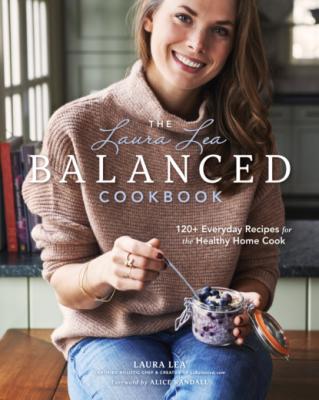The Laura Lea Balanced Cookbook. Laura Lea
Читать онлайн.| Название | The Laura Lea Balanced Cookbook |
|---|---|
| Автор произведения | Laura Lea |
| Жанр | Кулинария |
| Серия | Laura Lea Balanced |
| Издательство | Кулинария |
| Год выпуска | 0 |
| isbn | 9781951217112 |
blanched almond flour, which is the finest
ground available. I order it online and store it
in the fridge, and it lasts for a long time. Feel
free to experiment with other brands, but I can’t
be sure how it will turn out. If you do not want
to purchase almond flour, you can substitute
it 1:1 for wheat-based flour. Note, however, that
almond flour requires more binder, so it won’t
be a perfect substitution.
Other uses: Outside of baking, I use blanched
almond flour instead of breadcrumbs in most
of my ground-meat recipes because it provides
moisture, richness, and a little extra protein. I
also use almond flour to coat chicken tenders
before baking, and it would be great as a
coating for chicken parmesan or pan-seared
shrimp as well.
Where to find: You can find brands of almond
flour in most grocery stores, health-food stores,
The Fresh Market, and Whole Foods. However,
I recommend ordering Honeyville brand from
honeyville.com, or from Amazon.
Arrowroot starch: Arrowroot starch is derived
from a tropical South American tuber plant.
I use it as a substitute for cornstarch as a
thickener in my recipes. The process of
extraction for arrowroot starch is gentler and
more natural than cornstarch, and it is non-
genetically modified, unlike many brands of
cornstarch. To use arrowroot starch properly,
you mix a tablespoon or two with an equal
amount of water until it dissolves, and then
add it into your hot soup or sauce. The result
is magical, as you watch your recipe gain
body and texture. If you do not want to invest
in arrowroot starch, you can absolutely use
cornstarch in its stead. However, please find
a brand of cornstarch labeled “Non-GMO” or
something similar.
Other uses: Use it as a coating before baking
or pan-frying vegetables or protein to make
them crunchy. Arrowroot can also substitute
for eggs as a binder in baked goods—try 1
tablespoon starch plus 1 tablespoon water for
each egg (you may need to adjust the liquid
ratio). I also keep some arrowroot in a shaker
and use it to make desserts look beautiful,
without having to use refined powdered sugar.
Where to find: Most health-food stores, Whole
Foods, The Fresh Market, Amazon, Thrive
Market, Vitacost
Chia seeds: Chia seeds, tiny black and grey
seeds that come from a plant in the mint
family, are near and dear to my heart. My first
post-corporate job was for Health Warrior, a
company that sells 100-calorie chia seed bars.
Although I now prefer to make my own bars,
I still rely on chia seeds. The benefits of the
little seeds fall into three main categories.
1. Nutrition: Chia seeds are high in fiber,
protein, omega-3 fats, calcium, and
magnesium, among other nutrients. That’s
some serious bang for your buck.
2. Multi-purpose: Chia seeds have an amazing
capacity to absorb a great deal of liquid.
As a result, soaking them in liquid for a
few hours or overnight creates a creamy,
pudding-like texture. In addition, chia
seeds are a great substitute for eggs in some
recipes, because they act as a binder (see
Subsituting Eggs on page 51).
3. Flavor: Mild! These poppy seed lookalikes
have a neutral flavor. This means you can
pair them with almost any sweet or savory
flavor. They form the base of my Chocolate
Chia Avocado Pudding (page 124), and they serve as a binder in my BBQ Chickpea & Sweet Potato Veggie Loaf (page 274). You can also sprinkle them on salads or use them to thicken soups.
Other uses: Stir them into oatmeal or
smoothies, or mix with water and a touch of
honey for a homemade workout “energy gel.”
Where to find: Most health-food stores, Whole
Foods, The Fresh Market, Amazon, Thrive
Market, Vitacost
Turmeric powder: Many spices have anti-
inflammatory properties, which means they
can help combat the common problem of
low-grade, chronic inflammation. You’re
probably familiar with clove, ginger, rosemary,
cinnamon, and cayenne pepper. But less
known is turmeric, a tuber from the same
plant family as ginger. Curcumin is the potent
antioxidant found in turmeric, and it has been
studied as a healing agent in autoimmune
diseases, liver damage, cancer, diabetes, and
more. Some stores sell turmeric whole, but I
prefer the ease of using it ground. Turmeric
has a mild, earthy flavor that blends well
with many other spices, and its gorgeous
golden color gives curry powder its signature
yellow tint. As a result, you will see turmeric
smattered throughout this cookbook,
complementing other ingredients and offering
its incredible health benefits. My Turmeric
& Tahini Roasted Cauliflower (page 189) is a reader favorite, and turmeric also stars in my Green Immuni-Tea (page 106).
Other uses: Throw a pinch into smoothies,
your
